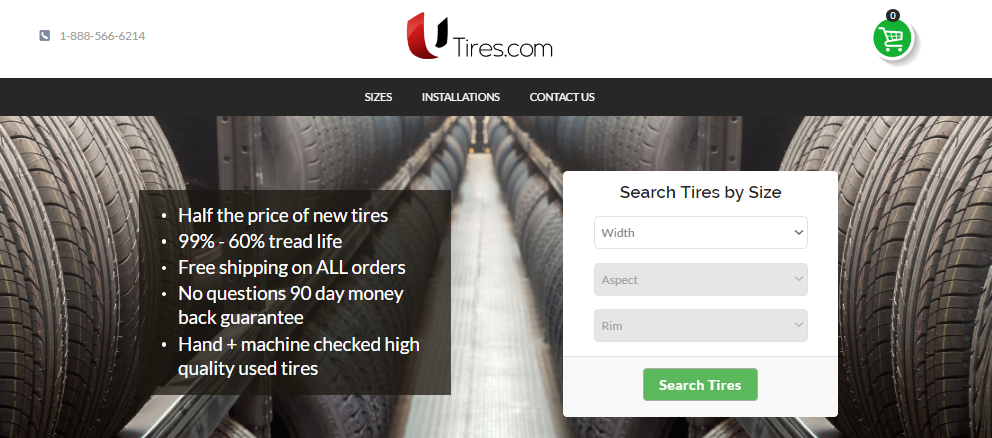There are several places and services you can visit to buy used tires:
- Tire stores, auto repair shops, etc.
- Junkyards.
- Online marketplaces.
- Specialized auto parts and tire online shores.
Where to Buy Used Tires: Pros and Cons of Each Option
Tire Stores
There are tire stores that sell both new and used items, as well as shops that specialize in used parts.
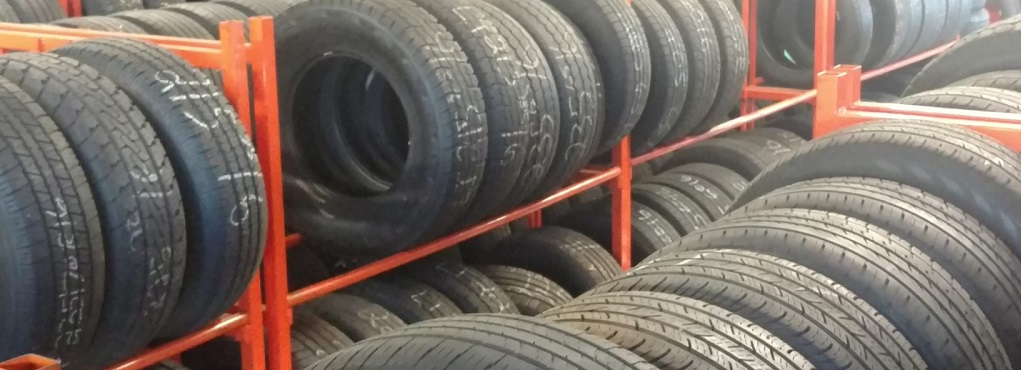
Pros
- Good quality tires.
The staff usually check the tires before putting them on sale. Often, the rubber is still in great condition, with most of the tread on it – even up to 10/32”. Many drivers change their tires every couple of years for safety or other Most new tire dealers don’t keep the tires that the customers leave and sell them to such used tire shops. - Experienced staff assistance.
You can ask the staff for a piece of advice on the type of tire you need, tire mixing, etc. and any other questions related to the tire choice. - Different payment options.
Most often, you can buy used tires either with cash or using your credit card. This is the advantage that brick-and-mortar facilities have over online shopping. - Additional services available.
Some stores also provide additional services, such as mounting and balancing second-hand tires. As you are buying your tires there, you may get a discount for those services or even have them all for free. In other cases, you may need to pay $15-$45 or more per tire for these services. - Ability to inspect the tires right away.
Before you buy used tires, you can check their condition yourself for as long as you need. Thus, you will be able to choose the tire that meets your top priorities.
Cons
- Limited range in-stock.
Tire stores usually have a limited range of used tire models to offer. There may also be no matching sets for your vehicle available. However, some shops may offer to order the tire you need from their warehouse, if any is available. - Possible scam.
Some sellers may offer you tires with patches and defects, or recalled items. Therefore, it’s vital that you give every tire of your choice a thorough look. Unfortunately, there are often people who buy used tires from sellers that make money on scrap tires that look well. - No warranty.
There is no warranty, as the tires are usually not of a particular shop but bought from other facilities or sellers. There is nothing to give it to, as the shop takes responsibility only for their choice of items to sell. If you buy used tires from a shop that provides repair to the pre-mounted tires they sell, you may get a warranty on the service performed.
Junkyards
Junkyards are places that store totaled vehicles crashed in accidents or those that malfunctioned beyond repair. While some of their parts may be useless, the tires are often very good. Anyone can purchase second-had tires from a junkyard themselves or arrange for a delivery to a repair shop.
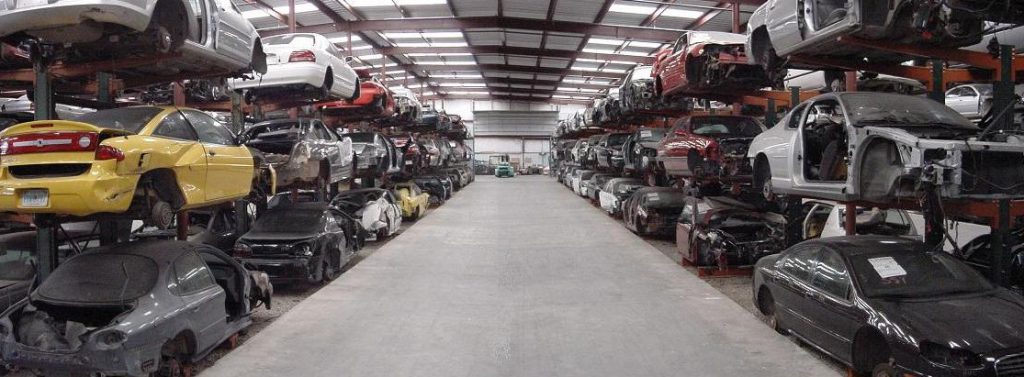
Pros
- Consultation on tire availability.
Before you buy used tires, consult the facility on the availability of the tires you need. Many junkyards have digital databases with information on the availability and location of every part they have. They may also help you to pick another model of tire with the same specifications that is available at the time. - Buying one tire is possible.
If only one tire on your vehicle is worn out or if you need to buy spare tire, you can get a good deal at a junkyard. One tire usually only costs you $10-50, depending on its condition. - Opportunity to inspect tires.
You have the opportunity to inspect the inner section of the tire, as junkyards usually sell tires without rims. You can check for internal damages, improper repairs, cuts, cracks, and other issues before you buy used tires. - Replacement policy.
Some junkyards have a special replacement policy that gives you a right to demand another part if yours fails too soon. The policies of different facilities usually vary, so you may need to prove to them you didn’t total the part yourself.
Cons
- Small chance of finding a matched set.
Finding a full set may be a problem, and even if you find the same model and size, their condition may be different. Different cars end up in junkyards for various reasons, and some tires from almost new sets get damaged along with their vehicle. - Undetectable damages.
Such problems can be uneven wear, belt damages, flat spots, etc. For example, if a tire was used on a misaligned wheel, it would have been wearing unevenly, and sometimes it’s very difficult to notice. However, once you mount the tire on the vehicle, you will notice how it will become troublesome to handle. If you buy used tires with such issues, it may be a total waste of money, as not all issues are reparable. - No warranty.
There is no warranty on the items they sell, even though some facilities have replacement policies. The reason is that there’s no proof of prior maintenance or the reason of the vehicle malfunction provided by the driver.
Online Marketplaces
Online services like Amazon, eBay, Craigslist, etc. can help you buy used tires with a great balance of price and condition.
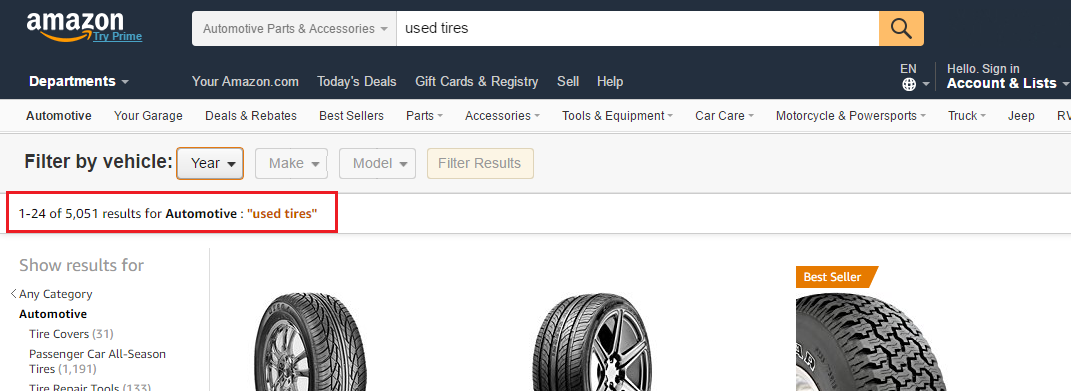
Pros
- Plenty of options.
You may find the same tire model in different conditions and for different prices. So, depending on your priorities, you can choose an option that suits you the best. On Amazon, there’s currently over 5,000 listings to choose from. - Opportunity to contact sellers.
Contacting the seller directly will help you make the right choice. The more you know about the item, the better your pick will be. You can also ask for a discount or discuss the details of the delivery. - Convenient delivery options.
You can choose from a variety of delivery options, like standard and urgent. Besides, you will save some time, as the package will be delivered to a specified address and you will not need to travel anywhere to get it. - Option comparison.
Some services provide a list of all options for the model, size, etc. you are looking for so you can compare them. You will find a brief description of the tires’ specs, their condition, and prices. This will help you see the best prices compared to those of new tires and choose the most suitable option. - Seller ratings and reviews.
You can find the best seller by looking at the rating he or she has. Some marketplaces also provide reviews and comments from clients that buy used tires frequently. This will help you be sure you will get exactly what you order for a reasonable price in a short period of time.
Cons
- No guarantee of sellers’ reliability.
There’s no guarantee you will get what you ordered, even though Web-based marketplaces may provide safety for your money. You may get a wrong tire, and the seller may be long gone from the service. Besides that, if you have to return the order, it will take additional time and money. - Waiting time.
Depending on the place you order from, several days (or sometimes weeks) may pass before you get your package. However, there are special fast delivery options that for a certain amount of money will help you get the item in a matter of days, sometimes hours. - Delivery costs.
There are free delivery options on some services that will make you wait for a week or more. However, if you want to get the tires sooner, you may need to pay an extra fee. The cost depends on the weight/size of the order, as well as the time. For example, Amazon provides Same-Day Delivery for $8.99 per order (+$0.99 per item). eBay has a more complicated system determining delivery costs. - No cash payments.
Shopping online requires a credit card and often a PayPal account. So, it may be inconvenient for the people who don’t own a bank account.
Specialized Auto Parts or Tire Online Shores
There are online-based stores that sell used tires as a part of a wider range of products and those selling only tires. They get the parts from drivers, buy them at junkyards, tire shops, etc. and resell them.
Pros
- Professional choice.
Professional staff test all the items and mention of their potential drawbacks in the descriptions. Besides, if you are not quite sure what you need, the shop’s staff will help you choose. - Wide range of options.
Most trustworthy online tire shops have a wide range of items with different sizes, of different ages and prices. Some used tires for sale may be with up to 10/32” tread and a year old. Yet, more money-saving option may be with 5/32” tread and 5-6 years old. - Convenient search.
You can search the needed items by size, age, etc., or by typing some vehicle information. Some online tire shops have sophisticated search systems where you can also find many options of the OE tires for your particular vehicle model. There are usually several tire brands that have items made specifically for one model. - Tire shop shipment.
Your order may be delivered right to the tire shop you choose from the list available on the store’s website. You can drive there when the order arrives and have your new tires installed in roughly an hour.
Cons
- Additional costs.
You may have to add up to $100-150 to your spending for installing the tires. Not all tire shops will provide mounting and balance for free if you didn’t buy used tires from them. Some services cooperate with tire shops and can recommend you a reliable local facility. - Differences in
Money-back guarantees, warranties, replacement policies can differ in different stores. So, before you buy used tires, make sure to read the term and conditions thoroughly. - Possible scam.
There are scammers that create services to sell scrap tires or no tires at all, taking customers’ money and creating false reviews. Before you choose a service, read all the necessary information on their website and ask them questions if you have any. Also, consider reading independed reviews online to find out all the pros and cons of a particular online shop.
Things to Check Before You Buy Used Tires
There is a number of things to check before you get pre-mounted tires:
- Tread depth.
Used tires may have different amount of tread, and the more there is, the better. 6/32” should be the starting point if you plan to ride the tires for at least a couple of years. Don’t get tires that have less than 4/32” tread left – they are bald and dangerous.
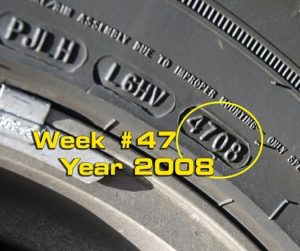 Date code on a tire sidewall.
Date code on a tire sidewall.
Tire age.
Find the DOT code on the tire’s sidewall and look at the last four digits. The first two numbers are the week, and the last two are the year of the tire’s manufacture. So, 2309 would be the 23rd week of 2009, and this tire should be considered old by now. It’s better to buy tires that are less than 6 years old. Tires that are older need to be fully checked every year and can pose a threat to your safety. Rubber starts to deteriorate once the tire is released, and it ages even if not used.
- Recall.
Before you buy used tires, check their Tire Identification Numbers (TINs – numbers and letters after DOT on your tire) using the Rubber Manufacturers Association (RMA) recall search tool. Manufacturers recall their tires when they find defects that may be dangerous to the items’ owners. - Damages.
Check for cuts, punctures, cracks, and bulges on the tread, sidewalls, and beads. Some scuffing is acceptable, but there should be no obvious damage, however small they are. There may be patches inside, meaning the tire was repaired. As not all the repairs make the tire operational again, it’s better to buy used tires without repairs. Also, look for any cord and wire exposure – there should be none, or the construction of the tire might be damaged.
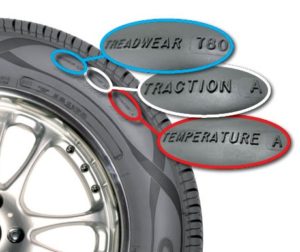 UTQG on a tire sidewall
UTQG on a tire sidewall
UTQG code.
The Uniform Tire Quality Grading is a system that shows estimates on the tire’s traction, treadwear, and temperature resistance. When you buy used tires, pay attention to the Treadwear grade: the higher the number is, the slower the tire wears. The most optimal variant will be a tire with the grade of 400-600. However, remember that long-lasting tires provide less performance and comfort.
- Uneven wear.
Uneven treadwear patterns indicate different problems with the vehicle the tires were on and the items themselves. For example, two-shoulder wear shows that the tire was underinflated. And this is a frequent cause of blowouts, so you shouldn’t buy such a tire. It will have a short life, wearing as unevenly as it did before and posing a danger to you and your vehicle.
Potential Pitfalls to Be Aware of When You Buy Used Tires
When buying second-hand tires, make sure you know about the following scam techniques some sellers use.
- Scrubbing the date codes off.
If a tire is too old yet appears new, some sellers may remove the date code from it. Tire aging is dangerous, and once you mount such a tire, the tread can separate at any moment. Dry cracks will be increasing in size rapidly when you inflate the tire. - Improper repairs.
When the irreparable damages are fixed, the tire loses air and the damage expands. For example, ozone cracks are irreparable, as once the reaction starts, it’s impossible to stop it. However, some people patch those cracks and sell them as “professionally repaired”.
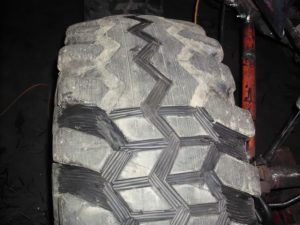 Bald tire re-grooving process
Bald tire re-grooving process
Regrooving.
Some worn out tires can be illegally regrooved to meet legal tread depth requirements. Such tires are prone to damages, as there is much less rubber left on them. Using such tires is also illegal, and you may be later fined to pay up to $1,000 per tire.
Another drawback is that you may lose your vehicle insurance. There are tires manufactured specifically for further regrooving, you can learn that by looking at the tire’s sidewall. However, most tires aren’t suitable for such a life-prolonging technique.
- Selling counterfeit tires.
Fake tires are manufactured to resemble the products of famous companies, but the materials are usually of lower quality. Such tires may bring a number of issues. Their tread life is completely unexpected, and they are also illegal. There is troubling report a of fake tires entering the US market, so it’s better not to buy used tires that are suspicious. It’s vital that you check every bit of code before you buy used tires. Manufacturer facility, TIN and date codes are especially important, as companies detect their tires using them. If the information seems suspicions to, contact the authorized dealers to check it. - Painting tires.
Some sellers paint old tires over to make them seem newer, as tires usually lose their deep dark color when aged. They can tell you that the tires were stored in proper conditions and even though the items are old, they are fully functional. However, once you mount such tires and start driving, the issues will become noticable. An old tire may cause unusual vibrations that can damage it and the wheel. Such tires usually have cracks, and even if they were hidden from your eye, they let air go out. This may cause a blowout and an accident. Besides, old tires barely hold together, so after a couple of hundred miles or even less the tread can separate from the rest of the tire, causing serious safety issues.
Where Should I Go to Buy Used Tires?
Your choice should depend on your priorities:
- Go to the closest junkyard if you need one or two used tires in relatively good condition as soon as possible.
- Go online and buy from another driver if you have some time to wait and want to choose from a variety of options and get the best quality and price balance.
- Choose an online used tire and car parts shop if you need an online consultation before choosing tires or help with the choice.
- Visit a local tire shop if you need on-site advice and prefer inspecting the tires yourself before purchase.
Overall, despite the list of disadvantages of buying second-hand tires, about 30 million used tires are sold in the US annually, making up around 10% of the overall tire market. This means that many drivers have found the benefits that such a purchase provides rather appealing.

